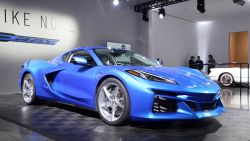Innovative companies are supposed to be better long-term investments than firms mired in complacency and stagnation — that’s obvious. But just how much better innovative companies performmay surprise you.
Companies that invest heavily in research and development made more than a 25% return over the past year, nearly double that of the S&P 500 (SPX), according to an index compiled by a strategist at Nomura’s Instinet subsidiary. The group of companies also beat the 19% gain for the tech-heavy Nasdaq 100 (NDX) index.
The index was created by Joseph Mezrich, the head of quantitative investment strategy at Instinet. It looked at companies in the Russell 1000 and weighted them by how much spending they do on research and development as a percentage of their total value compared to similar companies in their respective industries.
Mezrich’s “Innovation Index” also has a great long-term track record. It has topped the broader market for the past 10, 20 and nearly 40 years. Since 1990, the Innovation Index has returned 20% on average, compared to 10% for the S&P 500 and 15.6% for the Nasdaq 100.
Mezrich told CNN Business that these results clearly show that investors reward companies that constantly try to find new products and ways to grow, rather than companies that use their capital primarily to repurchase shares. The latter strategy may only give a stock a short-term boost.
“It’s always good to be innovative,” Mezrich said. “A company has to constantly make decisions about whether to buy back more stock or invest in research. That’s the tension.”
Smaller firms are bigger innovators
Tech firms dominate the Innovation Index: Qualcomm (QCOM), Juniper Networks (JNPR), FireEye (FEYE), Western Digital (WDC) and Symantec (SYMC) are among the 10 largest holdings.
All of those companies outrank even the biggest tech companies, including Microsoft (MSFT), Apple (AAPL), Amazon (AMZN), Google owner Alphabet (GOOGL), Facebook (FB) and Netflix (NFLX). None of those are among the index’s top holdings.
Smaller firms need to remain innovative to compete with rivals that are much larger and have the resources to spend more on acquisitions and marketing. Qualcomm, while no slouch, competes with chip heavyweight Intel (INTC), while Juniper Networks has to contend with the significantly larger Cisco (CSCO). Both Intel (INTC) and Cisco (CSCO) are Dow components.
But innovation isn’t just for tech.
Take a look at the food industry, for example. Mezrich mentioned two companies that have gone in opposite directions.
“Kraft Heinz (KHC) has been crushed this year while Beyond Meat (BYND) is surging,” he said. The former focused on cost cutting more than it did new products, while the latter is a leader in the burgeoning market for plant-based foods.
“One invested in innovation and the other didn’t,” Mezrich said.
Beyond Meat is too young of a company to be in the index — it only recently went public. But there is one food stock among the top 20 holdings: Kellogg (K).
In 2017, the company bought startup Chicago Bar Company, which makes the popular RXBar protein bar. Kellogg has focused more on protein bars, nut spreads and other food products that are growing more rapidly than packaged cereal.
Mezrich said that focus has helped Kellogg shares hold up better than the makers of other struggling supermarket staples, including Kraft Heinz and Campbell Soup (CPB).
Old industrial companies succeed
Mezrich said that perhaps the biggest surprise he found when creating the Innovation Index is how many older industrial companies are in it.
There’s a bigger percentage of basic materials firms than tech hardware companies, for example. And capital goods companies have a larger weighting in the index than software.
Farm equipment company AGCO (AGCO) is the fourth-largest holding. That is particularly interesting since its larger rival Deere (DE) has struggled lately because of poor tractor sales and concerns about China tariffs.
Although Deere’s shares have tumbled 10% this year, AGCO is up 20%. AGCO has used augmented reality technology to help manufacture tractors and also has combines for harvesting grain that can be operated with touch-screen tablets.
Other companies in the index that you might be surprised to hear rank highly for innovation: Petroleum additives company NewMarket; Terex (TEX), a manufacturer of cranes and other construction equipment; and engine maker Cummins (CMI).


























